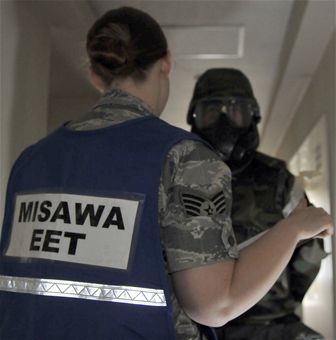 |
| News > OREs: being successful from “StartEX to EndEX” |
 |
 |
| |
| Photos | |
 |
MISAWA AIR BASE, Japan—Staff Sgt. Rachel Martinez, Misawa Exercise Evaluation Team member performs a pre-exercise inspection with Staff Sgt. April Quintanilla, 35th Fighter Wing Public Affairs photographer June 29 at the 35th FW Headquarters building. EET assists the 35th FW Inspector General’s Office to ensure all Airmen are exercise ready. (U.S. Air Force photo/Tech. Sgt. Phillip Butterfield)
|
Download HiRes
|
|
|
|
OREs: being successful from “StartEX to EndEX”
Posted 6/28/2011 Updated 6/28/2011
 Email story
Print story
Email story
Print story

by Tech. Sgt. Phillip Butterfield
35th Fighter Wing Public Affairs
6/28/2011 - MISAWA AIR BASE, Japan -- An Airman sits behind his computer and an operational readiness exercise reminder pops up on his screen. "Another exercise," the Airman exclaims. "The last one was brutal. We were getting written up on everything. I wonder who plans these things and what do we have to do make them easier on us?"
The 35th Fighter Wing's mission is to "help defend Japan and promote regional security in the Pacific by providing forward presence, deployable forces, and quality mission support." This means being able to go anywhere in the Pacific and possibly engaging enemy forces -- Misawa's Airmen must be ready.
The wing ensures this level of readiness by training its Airmen on how to operate in combat situations and then testing them on those skills, usually through operational readiness exercises.
"We need OREs because they help us sustain our required combat skill sets," said Senior Master Sgt. Kim Harper, 35th Fighter Wing Inspector General team chief. "Part of being an Airman is being able to quickly mobilize, providing life-saving first aid to a wingman, operating in a chemical warfare environment and defending the base."
These skills don't come naturally. They need to be taught, then tested. In order to define the criteria for testing, wing leadership partners with the inspector general's office to create a playbook of expectations.
"We meet with base leadership to develop a clear, concise set of guidelines and concrete direction on what leadership wants tested during the inspection," said Sergeant Harper. "Basically, we define a common goal for success."
Some of the areas inspectors test are the proper employment of entry control points, self-aid and buddy care techniques and mission-oriented protective posture levels.
Other areas inspectors observe are proficiency in Air Force specialties, proper markings on chemical gear, knowledge of the Airman's Manual and ability to operate and survive in a combat environment. Attitude and enthusiasm and the situational awareness to know what needs to get done next are also key components of success, Sergeant Harper said.
"There is no quick road to success, but Airmen working together as wingmen will guarantee that success."
In preparation for an operational readiness inspection later in the year, the wing will hold many more exercises in the months ahead.
"This is our time," said Col. Michael Rothstein, 35th Fighter Wing commander. "We need to make sure we have all of our processes perfected before the ORI. By making the most of OREs, we're better prepared, not only for ORIs but for our primary role in operations downrange."
|
|
|
|
|
|
 |
|



